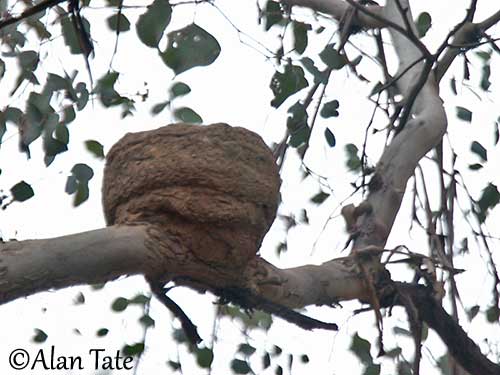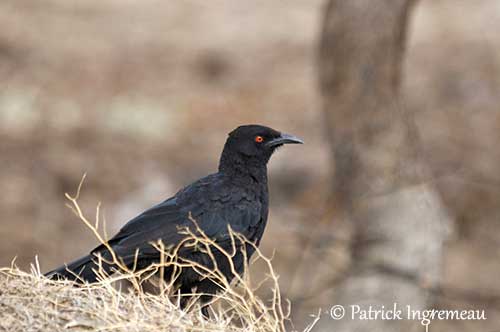
PROTECTION / THREATS / STATUS:
The White-winged Chough is widespread but uncommon. In many localities where the habitat has been destroyed and the leaf litter lost, the populations are rather fragmented.
They are affected by degradation of their habitat for agriculture expansion, fires, drought and increasing aridity that prevent nest-building because the mud is lacking.
However, the species occurs in numerous national parks and various protected areas.
The population is considered stable and the species is not globally threatened.
The White-winged Chough is currently evaluated as Least Concern.
Fr: Corbicrave leucoptère
Ang: White-winged Chough
All: Drosselkrähe
Esp: Corvino Negro
Ita: Gracchio alibianche
Nd: Modderkraai
Sd: kidnapparfågel
Photographers:
Ken Havard
My Bird Gallery & Flickr gallery 1 & Flickr gallery 2
Patrick Ingremeau
TAMANDUA
Alan & Ann Tate
AA Bird Photography
Text by Nicole Bouglouan
Sources :
HANDBOOK OF THE BIRDS OF THE WORLD Vol 14 by Josep del Hoyo-Andrew Elliot-David Christie - Lynx Edicions – ISBN: 9788496553507
BIRDS OF AUSTRALIA by Peter Rowland – Ed: Louise Egerton - ISBN: 1864363436
Field Guide to Australian Birds by Michael Morcombe - Editeur: Steve Parish Publishing Pty Ltd – ISBN-10: 187628210X -ISBN-13: 978-1876282103 - 448 pages
The Graham Pizzey & Frank Knight Field Guide to the Birds of Australia - Publisher: HarperCollins Publishers (Australia) Pty Ltd; Reprint. Edition (1996) - ISBN-10: 020718013X - ISBN-13: 978-0207180132 - 528 pages
The Cornell Lab of Ornithology - Birds of the World
Birds in backyards (Birds Australia and Australian Museum)
Kidnapping and reciprocity in cooperatively breeding white-winged choughs
Wikipedia, the free encyclopaedia
White-winged Chough
Corcorax melanorhamphos
Passeriformes Order – Corcoracidae Family
INTRODUCTION:
The White-winged Chough is very similar to Corvidae, but it belongs to the family Corcoracidae which include two mud-nest builders. The other member is the Apostlebird.
These species are very gregarious and live in closely bonded family groups that share numerous activities throughout the year, including during the breeding season. The flocks may contain 4 to 20 individuals. They are strongly terrestrial and forage mainly on the ground where they feed on insects and larvae, earth worms, snails and others.
They are known for their large, bowl-shaped mud-nests built on horizontal branch in tree. They perform co-operative breeding and the groups include the young of the previous years.
The White-winged Chough is found in E Australia, from E half of Queensland to S and SE of South Australia. Two subspecies share this large range.
They frequent dry forests, eucalypt woodlands and other tree species, crops, pastures, lawns, outer suburbs, and usually habitat providing abundant, thick leaf litter across open ground.
The White-winged Chough is widespread, but the subspecies “whiteae” is rare. They are affected by habitat clearance for agriculture expansion, and destruction of the ground litter by wildfires, but also by human activities.
The White-winged Chough is not globally threatened and currently evaluated as Least Concern.

DESCRIPTION OF THE BIRD:
Biometrics:
Length: 44-50 cm
Weight: 280-425 g
The White-winged Chough of nominate race appears entirely black when the wings are folded. The white wing patch is hidden in the folded wings, but when they are drooped, we can see several white lines. The large, rounded white patch is on the flight-feathers, across most of the primaries. It is conspicuous in flight. The long tail is entirely black and extends far beyond the tips of the folded wings.
The bird in fresh plumage shows some greenish gloss on head feathers, whereas in worn plumage, it is tinged brownish.
The black bill is strongly downcurved at the base, giving a drooping appearance to the entire bill. The eyes are red-orange, with dark pink outer ring which may sometimes turn red when the bird is excited or aggressive. Legs and feet are dark grey to blackish.
Male and female are similar.
The juvenile is rather brownish-black with fluffy plumage. The tail is shorter than in adults. The eyes are dark.
The immature resembles adult, but it has brown eyes becoming gradually red-orange over 3-4 years.
SUBSPECIES AND RANGE:
The White-winged Chough has two subspecies.
C.m. melanorhamphos (described above and displayed) is found in E Australia, from E half of Queensland, S to New South Wales (except NW), Victoria, and SE South Australia (Mts Lofty Ranges).

C.m. whiteae (not displayed) occurs in S and SE South Australia (Eyre Peninsula and Mts Lofty Ranges).
It is very similar to nominate, but it is smaller. The bill is slightly shorter and thinner. The white wing patch may be washed pinkish.
HABITAT:
The White-winged Chough frequents open forests and eucalypt woodlands. It usually favours the wet areas with thick leaf litter for foraging, and mud to build the nest. Other types of habitats include timbered watercourses margins, plantations of pines and cypress, farmlands, crops, pastures, lawns and outer suburbs.
CALLS AND SONGS: SOUNDS BY XENO-CANTO
The White-winged Chough gives mournful, mellow whistles and also produces throaty clicks.
The whistling song begins as a high, clear, musical whistle, descending and becoming mellower. Then, there is a pause before to utter a rising high and clear whistle again, ending in long downwards slide. It is described as “t-i-e-e-e-ew, t-i-e-e-e-uw, t-i-e-e-uuw”. This song is often given by several members of a group.
When the birds are threatened or aggressive, they give harsh, rasping sounds “ch-z-z-zark” becoming a continuous unpleasant noise.
BEHAVIOUR IN THE WILD:
The White-winged Chough feeds mainly on insects and larvae (termites and beetles), earthworms and snails, especially in summer, whereas seeds are mostly taken in winter. It may occasionally take small mammals.
It forages mainly on the ground by moving forwards in scattered groups, stopping to probe or scratch the leaf litter for various prey. To find a prey involves much excitement among the group.
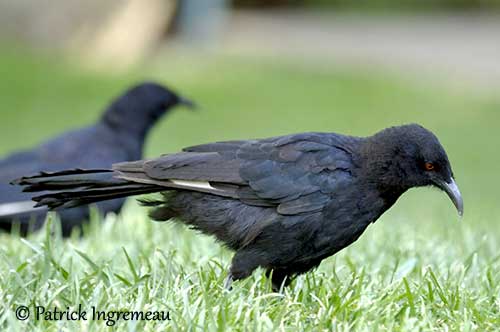
The White-winged Chough performs communal nesting and breeding. The young are raised by all the family members over several years. The breeding success is higher in larger families.
This species nests in a deep, cup-shaped structure made with grasses and mud. It is placed on horizontal branch, up to 10 metres above the ground. The nesting duties are shared by all the family members.
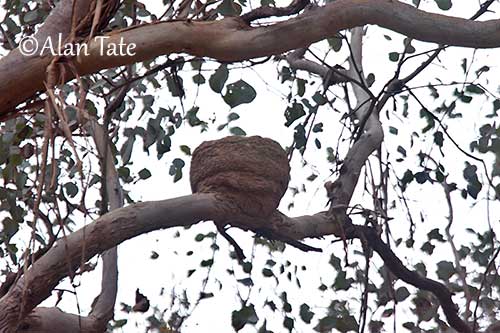
The White-winged Chough is sedentary and wanders throughout the large home range.
This species flies to escape a danger and to travel between feeding sites, and the members of a group fly together.
It flies with slow, deep wingbeats interspersed with glides on flat wings, and the white wing patches are displayed. It also climbs branches in flying bounds.
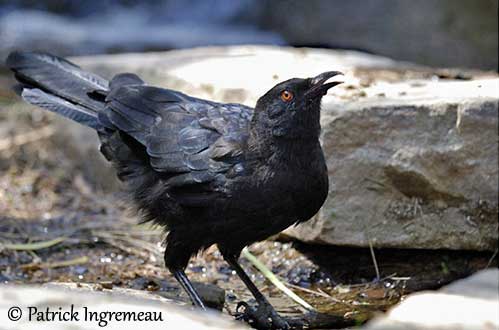
REPRODUCTION OF THIS SPECIES:
The laying occurs in September/December, but this species can also breed after rain in drier areas, at other times of the year. It may produce two broods per season.
The White-winged Chough is a co-operative breeder. This species has never been observed to breed successfully without helpers. These helpers contribute to all the nesting duties, including nest-building and incubation. The youngest helpers are one year old and less.
The small groups of 3-7 individuals are not able to support even only one young through its first winter. The groups grow very slowly as members are recruited through the reproduction.
From observations in the wild, some groups are known to raid their neighbours in order to kidnap the recently fledged young. These young birds are not related to their new family, but they may become helpers within this new group. A group usually consist of one breeding pair and up to 16-18 helpers.
Choughs are aggressive between groups, both during and after nesting. Large groups harass small groups, and even the nests are sometimes dislodged from the tree.
During aggressive displays, the white wing patches are enhanced by wing-wave and tail-wag displays while the opponents are perched in tree, lining up along opposite branches. The eyes are engorged with blood, making the eyering conspicuous, and the birds call continuously.
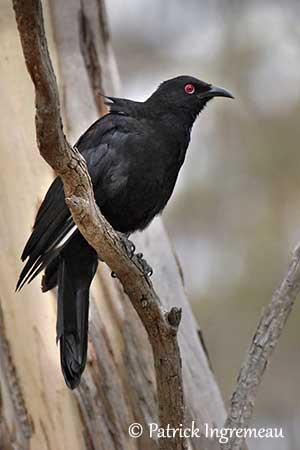
All members take part in nest-building. The nest is a large bowl of mud, but other materials such as manure can be added too. These materials are bound and lined with bark, grass and animal fur. The nest is built on horizontal branch, between 6 and 10 metres above the ground, often in eucalypt tree.
The female lays 3-5 creamy-white eggs with brown and lilac markings. The incubation lasts 19-20 days, shared by all members that also help to brood and feed the chicks. The nesting period lasts 24-30 days.
The young birds are raised by the non-breeding helpers, and the female usually lays a second clutch. The juveniles are independent 6-7 months later. They remain in the group and become helpers.
The pairs without helpers are not able to breed successfully.
